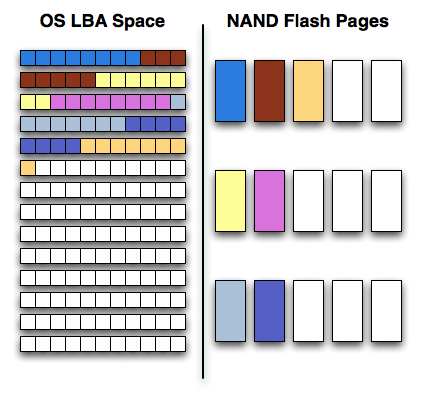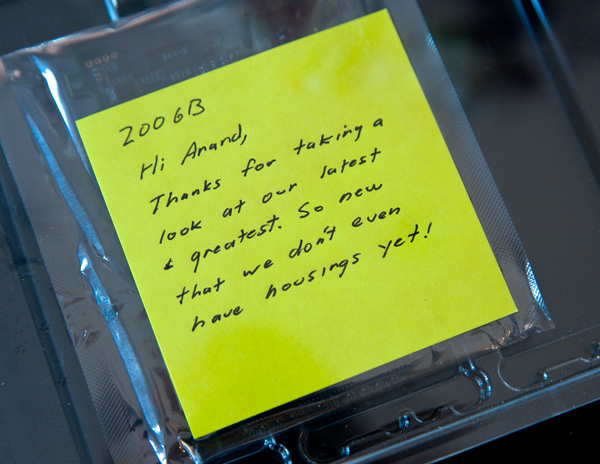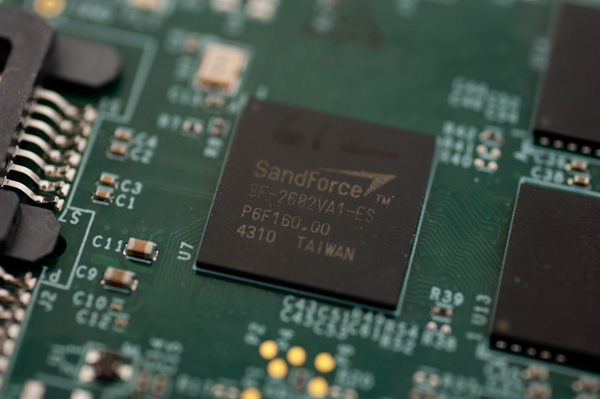OCZ Vertex 3 Pro Preview: The First SF-2500 SSD
by Anand Lal Shimpi on February 17, 2011 3:01 AM ESTFor the past six months I've been working on research and testing for the next major AnandTech SSD article. I figured I had enough time to line up its release with the first samples of the next-generation of high end SSDs. After all, it seems like everyone was taking longer than expected to bring out their next-generation controllers. I should've known better.
At CES this year we had functional next-generation SSDs based on Marvell and SandForce controllers. The latter was actually performing pretty close to expectations from final hardware. Although I was told that drives wouldn't be shipping until mid-Q2, it was clear that preview hardware was imminent. It was the timing that I couldn't predict.
A week ago, two days before I hopped on a flight to Barcelona for MWC, a package arrived at my door. OCZ had sent me a preproduction version of their first SF-2500 based SSD: the Vertex 3 Pro. The sample was so early that it didn't even have a housing, all I got was a PCB and a note:
Two days isn't a lot of time to test an SSD. It's enough to get a good idea of overall performance, but not enough to find bugs and truly investigate behavior. Thankfully the final release of the drive is still at least 1 - 2 months away, so this article can serve as a preview.

The Architecture
I've covered how NAND Flash works numerous times in the past, but I'll boil it all down to a few essentials.
NAND Flash is non-volatile memory, you can write to it and it'll store a charge even if you remove power from the device. Erase the NAND too many times and it will stop being able to hold a charge. There are two types of NAND that we deal with: single-level cell (SLC) and multi-level cell (MLC). Both are physically the same, you just store more data in the latter which drives costs, performance and reliability down. Two-bit MLC is what's currently used in consumer SSDs, the 3-bit stuff you've seen announced is only suitable for USB sticks, SD cards and other similar media.

Writes to NAND happen at the page level (4KB or 8KB depending on the type of NAND), however you can't erase a single page. You can only erase groups of pages at a time in a structure called a block (usually 128 or 256 pages). Each cell in NAND can only be erased a finite number of times so you want to avoid erasing as much as possible. The way you get around this is by keeping data in NAND as long as possible until you absolutely have to erase it to make room for new data. SSD controllers have to balance the need to optimize performance with the need to write evenly to all NAND pages. Conventional controllers do this by keeping very large tables that track all data being written to the drive and optimizes writes for performance and reliability. The controller will group small random writes together and attempt to turn them into large sequential writes that are easier to burst across all of the NAND devices. Smart controllers will even attempt to reorganize data while writing in order to keep performance high for future writes. All of this requires the controller to keep track of lots of data, which in turn requires the use of large caches and DRAMs to make accessing that data quick. All of this work is done to ensure that the controller only writes data it absolutely needs to write.

SandForce's approach has the same end goal, but takes a very different path to get there. Rather than trying to figure out what to do with the influx of data, SandForce's approach simply writes less data to the NAND. Using realtime compression and data deduplication techniques, SandForce's controllers attempt to reduce the size of what the host is writing to the drive. The host still thinks all of its data is being written to the drive, but once the writes hit the controller, the controller attempts to reduce the data as much as possible.

The compression/deduplication is done in realtime and what results is potentially awesome performance. Writing less data is certainly faster than writing everything. Similar technologies are employed by enterprise SAN solutions, but SandForce's algorithms are easily applicable to the consumer world. With the exception of large, highly compressed multimedia files (think videos, MP3s) most of what you write to your HDD/SSD is pretty easily compressible.
You don't get any extra space with SandForce's approach, the drive still has to accommodate the same number of LBAs as it advertises to the OS. After all, you could write purely random data to the drive, in which case it'd behave like a normal SSD without any of its superpowers.
Since the drive isn't storing your data bit for bit but rather storing hashes, it's easier for SandForce to do things like encrypt all of the writes to the NAND (which it does by default). By writing less, SandForce also avoids having to use a large external DRAM - its designs don't have any DRAM cache. SandForce also claims to be able to use its write-less approach in order to use less reliable NAND, in order to ensure reliability the controller actually writes some amount of redundant data. Data is written across multiple NAND die in parallel along with additional parity data. The parity data occupies the space of a single NAND die. As a result, SandForce drives set aside more spare area than conventional controllers.
What's New
Everything I've described up to this point applies to both the previous generation (SF-1200/1500) and the new generation (SF-2200/2500) of SandForce controllers. Now let's go over what's new:
1) Toggle Mode & ONFI 2 NAND support. Higher bandwidth NAND interfaces mean we should see much better performance without any architectural changes.
2) To accommodate the higher bandwidth NAND SandForce increased the size of on-chip memories and buffers as well as doubled the number of NAND die that can be active at one time. Finally there's native 6Gbps support to remove any interface bottlenecks. Both 1 & 2 will manifest as much higher read/write speed.
3) Better encryption. This is more of an enterprise feature but the SF-2000 controllers support AES-256 encryption across the drive (and double encryption to support different encryption keys for separate address ranges on the drive).
4) Better ECC. NAND densities and defect rates are going up, program/erase cycles are going down. The SF-2000 as a result has an improved ECC engine.

All of the other features that were present in the SF-1200/1500 are present in the SF-2000 series.












144 Comments
View All Comments
sheh - Thursday, February 17, 2011 - link
Why's data retention down from 10 years to 1 year as the rewrite limit is approached?Does this mean after half the rewrites the retention is down to 5 years?
What happens after that year, random errors?
Is there drive logic (or standard software) to "refresh" a drive?
AnnihilatorX - Saturday, February 19, 2011 - link
Think about how Flash cell works. There is a thick Silicon Dixoide barrier separating the floating gate with the transistor. The reason they have a limited write cycle is because the Silion dioxide layer is eroded when high voltages are required to pump electrons to the floating gate.As the SO2 is damaged, it is easier for the electrons in the floating gate to leak, eventually when sufficient charge is leaked the data is loss (flipped from 1 to 0)
bam-bam - Thursday, February 17, 2011 - link
Thanks for the great preview! Can’t wait to get a couple of these new SDD’s soon.I’ll add them to an even more anxiously-awaited high-end SATA-III RAID Controller (Adaptec 6805) which is due out in March 2011. I’ll run them in RAID-0 and then see how they compare to my current set up:
Two (2) Corsair P256 SSD's attached to an Adaptec 5805 controller in RAID-0 with the most current Windows 7 64-bit drivers. I’m still getting great numbers with these drives, almost a year into heavy, daily use. The proof is in pudding:
http://img24.imageshack.us/img24/6361/2172011atto....
(1500+ MB/s read speeds ain’t too bad for SATA-II based SSD’s, right?)
With my never-ending and completely insatiable need-for-speed, I can’t wait to see what these new SATA-III drives with the new Sand-Force controller and a (good-quality) RAID card will achieve!
Quindor - Friday, February 18, 2011 - link
Eeehrmm.....Please re-evaluatue what you have written above and how to preform benchmarks.
I too own a Adaptec 5805 and it has 512MB of cache memory. So, if you run atto with a size of 256MB, this fits inside the memory cache. You should see performance of around 1600MB/sec from the memory cache, this is in no way related to what your subsystem storage can or cannot do. A single disk connected to it but just using cache will give you exactly the same values.
Please rerun your tests set to 2GB and you will get real-world results of what the storage behind the card can do.
Actually, I'm a bit surprised that your writes don't get the same values? Maybe you don't have your write cache set to write back mode? This will improve performance even more, but consider using a UPS or a battery backup cache module before doing so. Same thing goes for allowing disk cache or not. Not sure if this settings will affect your SSD's though.
Please, analyze your results if they are even possible before believing them. Each port can do around 300MB/sec, so 2x300MB/sec =/= 1500MB/sec that should have been your first clue. ;)
mscommerce - Thursday, February 17, 2011 - link
Super comprehensible and easy to digest. I think its one of your best, Anand. Well done!semo - Friday, February 18, 2011 - link
"if you don't have a good 6Gbps interface (think Intel 6-series or AMD 8-series) then you probably should wait and upgrade your motherboard first""Whenever you Sandy Bridge owners get replacement motherboards, this may be the SSD you'll want to pair with them"
So I gather AMD haven't been able to fix their SATA III performance issues. Was it ever discovered what the problem is?
HangFire - Friday, February 18, 2011 - link
The wording is confusing, but I took that to mean you're OK with Intel 6 or AMD 8.Unfortunately, we may never know, as Anand rarely reads past page 4 or 5 of the comments.
I am getting expected performance from my C300 + 890GX.
HangFire - Friday, February 18, 2011 - link
OK here's the conclusion from 3/25/2010 SSD/Sata III article:"We have to give AMD credit here. Its platform group has clearly done the right thing. By switching to PCIe 2.0 completely and enabling 6Gbps SATA today, its platforms won’t be a bottleneck for any early adopters of fast SSDs. For Intel these issues don't go away until 2011 with the 6-series chipsets (Cougar Point) which will at least enable 6Gbps SATA. "
So, I think he is associating "good 6Gbps interface) with 6&8 series, not "don't have" with 6&8.
semo - Friday, February 18, 2011 - link
Ok I think I get it thanks HangFire. I remember that there was an article on Anandtech that tested SSDs on AMD's chipsets and the results weren't as good as Intel's. I've been waiting ever since for a follow up article but AMD stuff doesn't get much attention these days.BanditWorks - Friday, February 18, 2011 - link
So if MLC NAND mortality rate ("endurance") dropped from 10,000 cycles down to 5,000 with the transition to 34nm manufacturing tech., does that mean that the SLC NAND mortality rate of 100,000 cycles went down to ~ 50,000?Sorry if this seems like a stupid question. *_*